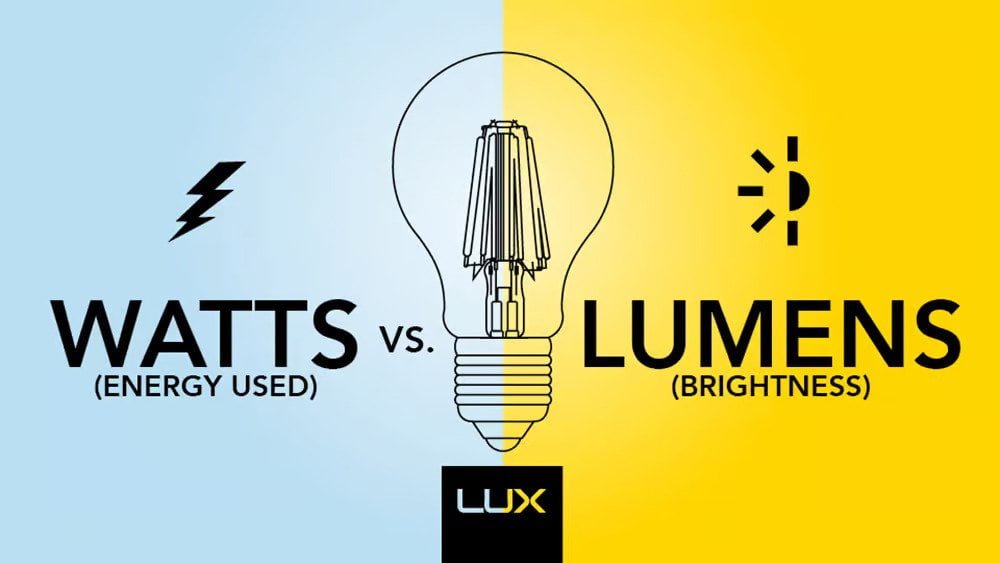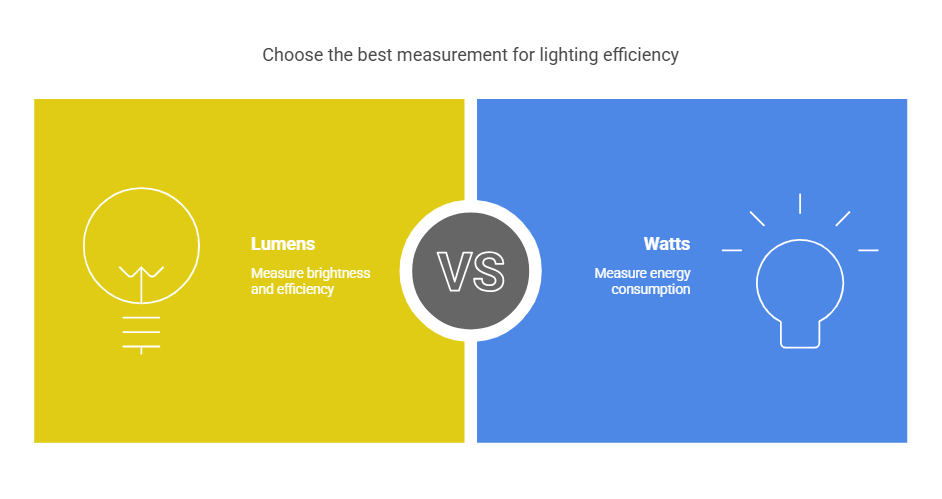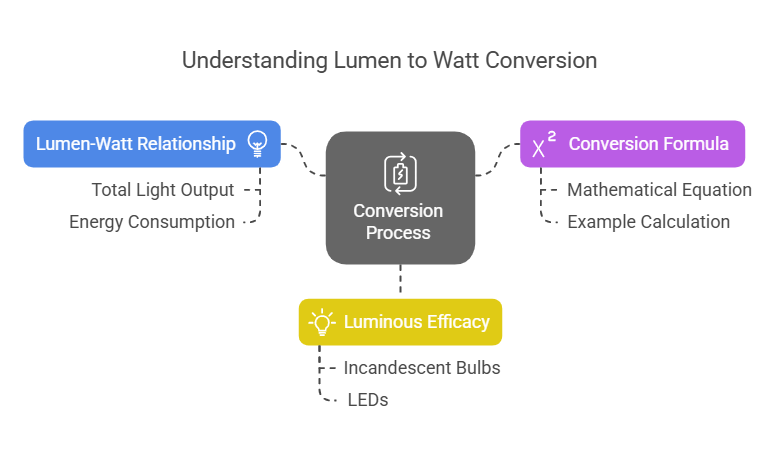The Comprehensive Guide to Converting Lumen to Watts
Table of Contents
Lumens and watts are two terms frequently associated with bulbs. Lumens measure the light intensity emitted by a bulb. A higher lumen count indicates a brighter light, while a lower count signifies a dimmer light. On the other hand, Watts indicate a light’s power consumption. A bulb with higher wattage will generally shine brighter. For instance, an 80-watt bulb emits more light than a 40-watt bulb.
Both lumens and watts are commonly referenced when discussing lamp output. To select the correct bulb type, it’s crucial to understand the relationship between lumens and watts, luminous efficacy, comparisons between various lighting technologies, and how to choose optimal light output. This article serves as your comprehensive guide on the subject.

Understanding Watts
Globally, when purchasing light bulbs, people often consider the wattage. Why? Watts indicate the energy consumption of a light source when it’s on. The wattage of a bulb gives consumers an idea of its brightness; a higher wattage typically signifies a brighter bulb, and vice versa.
Inspecting a bulb closely reveals its filament, the part where electricity flows to produce light and heat.
Innovation and technology have revolutionized light bulb designs, making them more energy-efficient. These newer bulbs not only save on electricity bills due to their efficiency but also tend to shine brighter than their older counterparts.
Understanding Lumens
Lumens can be considered the measure used to describe the brightness of a light bulb. The greater the lumen count, the brighter the bulb will appear; conversely, a lower lumen count indicates less brightness. Accurately measuring lumens requires understanding a light bulb’s internal reflection physics.
This measure is more precise than other units to determine a bulb’s brightness. It tells us how effectively a light bulb emits light without factoring in its electricity consumption.
Lumens are abbreviated as “lm” and represent the perceptible light emitted from a source to the human eye. Essentially, lumens serve as the metric for gauging the brightness of a light source.
Recently, there’s been an emphasis on energy-saving light sources. In this shift, the focus is on producing brighter light with reduced electricity use.
So, how many lumens are needed for a well-lit environment? The answer depends on various factors, such as the room’s size, ceiling height, individual needs, and the specific type of light source. Generally, lighting recommendations are often given per square meter (10.76 square feet), with room dimensions playing a significant role. For instance, a kitchen might require 300 to 400 lumens per square meter, while a bathroom might need 500 to 600 lumens per square meter.
Lumens vs. Watts: A Side-by-Side Examination

Comparison
Functionality
Lumens serve as an indicator of a light source’s brightness. The higher the lumens, the brighter the light; the inverse is also true. This brightness, however, varies with different light sources based on the technologies they employ to convert electric energy into light. On the other hand, Watts measure a bulb’s power consumption. A brighter light with a lower wattage showcases an achievement in energy-efficient lumens.
Standardization
Lumens offer a precise measurement of the light emitted by a source. Assessing a bulb’s brightness can be a challenge. Thus, one can refer to its wattage as it reflects the bulb’s brightness level.
Contrast
Lumens and Watts Connection
A 100W incandescent bulb typically emits around 1600 lumens. First, 1 watt equals 16 lumens, derived from dividing 1600 lumens by 100W.
Translating Lumens to Watts
To convert lumens to watts, it’s vital to understand luminous efficacy, measured in lm/W. Determining luminous efficacy requires knowledge of the light’s power and wattage. Capacity is calculated by dividing the light flux by the luminous efficacy.
Comparative Overview of Bulb Varieties
This table will highlight the unique characteristics of various bulb types, including Incandescent, Halogen, CFL, and LED. Upon viewing the table, readers can quickly identify the attributes distinguishing one bulb type from another.
| Features | Incandescent | Halogen | CFL | LED |
| Consumption | 100w | 70w | 20w | 12w |
| Efficiency | Low | Low | Medium | High |
| Average Lifespan | One year | 1-2 years | Ten years | 25 + years |
| Price | Low | Low | Medium | High |
| Operating Cost | High | Medium | Low | Low |
Converting Lumens to Watts

1. Understanding the Lumen-Watt Relationship
Lumens and watts represent distinct aspects of light bulbs. Lumens quantify the total light output of a source, while watts denote the bulb’s energy consumption. Although watts don’t specifically indicate a light’s brightness, lumens provide a comprehensive understanding. For instance, a 60W incandescent bulb might emit between 650-850 lumens. If we take 750 lumens as the average output, then 1 watt approximately equals 12.5 lumens.
2. Formula for Conversion
In physics, lumens are denoted by “lm”. At the same time, watts are represented by “W”. Lumens serve as the primary unit for luminous flux, referring to the amount of light emitted by a source per unit of time over a specific area. On the other hand, a watt stands as the unit for electrical power, defined in terms of joules per second.
For the conversion process, the formula can be described as flux divided by luminous efficacy equals power, or lm / (lm/W) = W. The resulting unit of this equation is lm/W.
3. Breaking Down the Conversion Formula
Let’s illustrate this with an example: If you aim to determine the power usage of a light source, like an incandescent bulb emitting a luminous flux of 1,120 lm with a luminous efficacy of 14 lm/W, the power it consumes is (1,120 lm) / (14 lm/W), which equals 80W.
4. Delving into Luminous Efficacy
Luminous efficacy can be considered the efficiency of producing lumens per watt. In simpler terms, it measures a bulb’s efficiency in turning watts into lumens. While older lighting technologies often had lower luminous efficacies, modern advancements have seen significant improvements. For instance, traditional incandescent bulbs might offer around 15 lumens per watt, while LEDs can achieve up to 140 lumens per watt. Such stark contrasts highlight the energy-efficiency strides in lighting technology.
Though watts don’t directly measure brightness, they give insight into a bulb’s luminous potential. It’s also worth noting that luminous efficacy can vary among manufacturers. Hence, to gauge a bulb’s efficiency, it’s crucial to consider the specific brilliant efficacy values provided by the manufacturer. LEDs consistently rank high in brilliant efficacy charts, often reaching values between 80-100 Lm/W.
Lumens Guide for Various Rooms
Kitchen
Bright lighting is crucial in the kitchen. For this reason, opting for LED bulbs ranging from 1000 to 1600 lumens is suggested. Bright light can also help you stay alert, especially during more relaxed times.
Dining Room
Consider bulbs in the 440 to 800 lumens range for a well-lit dining atmosphere. These softer lights are ideal for dining, particularly in warmer settings.
Living Room
The living room, a space for relaxation and sometimes work, requires a lighting range of 230 to 440 lumens.
Bedroom
Bedrooms, as places of rest, often benefit from softer lighting. It’s advisable to go for lights around 230 to 270 lumens and to consider warmer, dimmer tones.
Home Office
Bright lighting aids concentration, which is essential in a workspace. With computers and laptops being primary fixtures, avoiding excessive eye strain is necessary. Thus, bulbs ranging from 800 to 1000 lumens are recommended.
Bathroom
A lumen range of 330 to 400 is advised for bathrooms where individual preferences vary. Adjust the lighting based on your choice and ambient temperature.
Workspace
A workspace requires optimal lighting for focus and energy. An estimated range of 8,000 to 10,000 lumens fits this need.
1. Understanding Light Bulb Labels
Always review bulb energy labels before purchase. They provide insights into the bulb’s energy efficiency, potential impact on electricity bills, and overall performance. The efficiency scale ranges from A++ (most efficient) to G (least efficient). Labels also indicate wattage, brightness range, lumens, and the bulb’s expected lifespan.
2. Color Rendering Index (CRI)
The CRI provides insights into how colours appear under a light source. Typically ranging from 0 to 100, a Halogen bulb boasts a CRI of 100. A CRI of 80 is acceptable, while a CRI of 90 is even more desirable.
3. Color Temperature
This indicates the appearance of light from a source, measured in Kelvin (K). Residential and commercial lights typically range from 2000K to 6500K, helping categorize them as “cool white” or “bright white” lights. Energy-efficient bulbs usually fall between 2700K and 3000K.
4. Light Emission Color
The light’s emission results from electromagnetic radiation, driven by electrons transitioning between energy states. Each transition corresponds to specific energy levels, defining the light’s wavelength and the emission spectrum. It’s essential to note that each element’s emission spectrum is unique.
Why Choose LED?
- Lifespan
LEDs outlast conventional bulbs thanks to the sophisticated technology they incorporate. They function 2-3 times longer than many other lighting types on average. - Directional Light Efficiency
LED technology is designed to emit light over a wide area, spanning 180 to 360 degrees. This covers a broad spectrum and allows precise redirection to eliminate unwanted glares in room corners. - Design Flexibility
LEDs typically have a compact design. This allows for various configurations, from groupings to standalone setups. Users can tailor their LED arrangements based on specific needs. - Superior Color Rendering Index (CRI)
The high CRI of LEDs, widely used worldwide, makes object visibility under their illumination more evident than even under natural light. - Varied Correlated Color Temperature (CCT)
LEDs offer a diverse spectrum of correlated colour temperatures (CCT). This characteristic indicates the light’s tone, ranging from warm and soothing to a yellowish glow, with pure white tones also available. - Minimal UV Rays Emission
LEDs emit light within a specific spectrum. As such, their infrared range is limited, leading to almost negligible UV ray emissions. This underscores their safety, highlighting the absence of harmful UV emissions. - Eco-friendliness
While traditional lighting solutions like mercury vapour or fluorescent bulbs can be environmentally detrimental, LEDs avoid such issues. They don’t use harmful substances to produce light, marking them as environmentally friendly. - Energy Efficiency
LEDs are low in power consumption, which translates to reduced electricity bills. This efficiency is why many prefer LEDs for indoor and outdoor illumination.
Conclusion
With the evolution of technology, there’s a surge in innovative components within the lighting sector. This progression highlights the energy-efficient nature of modern light sources. Although these newer innovations swiftly surpass traditional options in advancement and market preference.
Through the discussion provided, readers should be able to discern the difference between watts and lumens. They must grasp the essential factors to consider when selecting a bulb and fully understand its features.
It’s widely recognized that LED lamps have found their place in homes worldwide, becoming a top choice for many. After delving into the “Why LEDs?” section, readers should understand the reasons behind their popularity. Further in the document, guidance on lumens is provided tailored to each room type.
For top-tier LED strips and LED neon flex, look no further than MyLikeLed. Our products undergo rigorous testing in advanced laboratories to guarantee exceptional quality. Plus, we provide bespoke solutions for our LED offerings. Reach out to MyLikeLed for unparalleled LED solutions!
FAQs
No, lumens and watts are not directly related. Lumens measure the brightness of a bulb, while watts measure the amount of energy it uses. However, both are important when choosing a light source because they help you understand how efficient the bulb is—how much brightness you get for the energy it consumes.
There is no fixed number because it depends on the type of bulb. For example:
- A 60W incandescent bulb gives about 750 lumens, so 1 watt = 12.5 lumens.
- A 20W halogen bulb gives around 263 lumens, so 1 watt = 13.15 lumens.
- A 6W LED bulb gives about 260 lumens, so 1 watt = 43.3 lumens.
In short, LEDs are much more efficient, providing more lumens per watt than incandescent or halogen bulbs.
It depends on where you’re using the light. For example, 800 lumens is great for a dining room, where a brighter setting is often preferred. It creates a welcoming and lively atmosphere for meals. In general, 400–800 lumens works well for most home lighting needs, depending on the room and purpose.
1000 lumens can cover a wide area or reach up to 150–200 meters when used in focused lighting (like a flashlight or spotlight). For indoor use, it’s suitable for medium to large rooms. However, the coverage also depends on how the light is distributed and the layout of the space.
The main difference is what they measure:
- Lumens measure the total light output from a bulb.
- Lux measures the amount of light that hits a specific area (lumens per square meter).
So, while lumens tell you how bright a light is in general, lux tells you how concentrated that light is in a certain space—very useful when planning task lighting or spotlighting.

Hi, I’m Xylia Xiong, a sales professional with 14 years of experience in the LED strip light industry. I specialize in providing tailored solutions, leveraging my expertise in LED products and the latest industry trends. Known for effective communication and problem-solving, I’m dedicated to helping lighting manufacturers, importers, and distributors achieve their goals.
Let’s work together to create customized solutions that exceed expectations.
Related Posts

The Best LED Strip Lights You Can Buy Right Now

Comparing WS2811 Vs WS2812B: Key Differences


